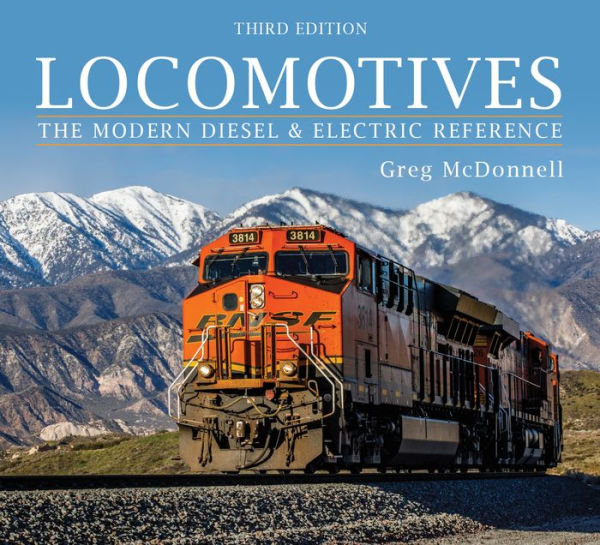INTRODUCTION WHAT ARE THESE DIESELS?
The headline appeared on a full-page ad in the February 1967 issue of Trains magazine and with it, a photograph and a promise. The photo was a Don Wood image of Pennsylvania Railroad Alcos, Baldwins, EMDs and FMs of every imaginable shape and size crowding the shop tracks in Altoona, Pa. The promise? "Just a glance through the all-new Diesel Spotter's Guide and you'll know their makers, model numbers, wheel arrangements, and horsepower." The first all-encompassing guide to North American diesels, Jerry A. Pinkepank's 304-page manual was, for diesel fans, just what the doctor ordered.
For a kid in school, filling the prescription was another matter. Money was always in short supply, and there were Beatle albums to buy and 45s and film and Trains magazine. It was a big day when the package marked with a Kalmbach "K" and a 1027 North 7th Street return address arrived in the mail. Pinkepank made good on the publisher's promise. In the pulp pages behind a glossy color cover adorned with the faces of SOO GP35 722, L and N C420 1306 and Santa Fe U28CG 358, the Diesel Spotter's Guide told all, from the oft-disputed difference between a GP7 and a GP9 to a detailed description of the Alco Blunt truck, to spotting details and production totals for everything from the Baldwin AS16 to the GE U50. It was the best three dollars and fifty cents I ever spent.
Forty years and half a dozen editions of the Spotter's Guide later, locomotives and railroading have changed immeasurably. The three units that graced the cover of the original DSG have long ago been scrapped, and the railroads that owned them have been swallowed up in mergers; GE, still considered a newcomer in the road-diesel trade when the first Diesel Spotter's Guide hit the stands, has been the number one locomotive builder in North America for more than 20 years ... and three dollars and fifty cents will buy a good cup of coffee.
Railroading, nevertheless, remains as exciting as ever, and the fascination of locomotives is undiminished by the consolidation of the continent's major railroads into a handful of supersystems. Through it all, Kalmbach and authors Jerry A. Pinkepank and Louis A. Marre maintained the standard established in 1967 with continuously updated versions of the diesel reference book known to generations of locomotive fans as simply "the DSG." This book aims to uphold the standard and honor the tradition of the Diesel Spotter's Guide.
This book picks up new locomotive production where Louis Marre's Diesel Locomotives: The First 50 Years (Kalmbach 1995) leaves off and updates the information first published in The Field Guide to Modern Diesel Locomotives (Kalmbach 2002). However, its starting point is not a single date. Electro-Motive coverage begins with the 1972 introduction of the Dash 2 series and all models cataloged at that time. This includes the SW1000, SW1001 and SW1500, switcher models that predate the Dash 2 but remained in production beyond 1972. General Electric coverage begins with the Dash 7 series, introduced in 1977. Wabtec's MotivePower Inc., along with its Morrison Knudsen/MK Rail/Boise Locomotive group predecessors, which began building locomotives at Boise, Idaho, in 1991, is also included, along with Alstom's Hornell, N.Y.-built PL42s, RailPower's hybrid Green Goats and the latest genset switchers from National Railway Equipment Co., RailPower Technologies Corp., MotivePower Inc., as well as locomotives from Brookville Equipment and ACS64 electrics from Seimens.
The scope of this volume has been broadened to include electric passenger locomotives currently in service on the Northeast Corridor. The limited number of electric freight locomotives, none of which are presently in common carrier service in North America, are not included. Electric locomotives built between 1972 and December 31, 1988, are included in Marre and Pinkepank's Contemporary Diesel Spotter's Guide (Kalmbach 1989).
Although the production of MLW-Bombardier falls within the chronological coverage of this volume, the fact that none of the company's locomotives remain in service on Class 1 railroads (in fact, very few remain in service in North America at all) precludes inclusion here. Pre-1977 GE U-series "U-boat" models are excluded for the same reason. Although a small number of U-series GEs do survive in the employ of short lines, the last U-boat in service on a Class 1 railroad, CSXT U23B 3305, was retired in 2000. All of these models are, however, included in Marre's Diesel Locomotives: The First 50 Years.
Industrial locomotives and rebuilds are outside the realm of this book. However, a few exceptions have been made: EMD BL20-2s, GE Super 7 locomotives and several Morrison Knudsen/Boise Locomotive models constructed using the frame and some remanufactured components from retired locomotives are included here. While convention dictates that a locomotive is defined by its frame, the aforementioned models are essentially new locomotives constructed on a recycled platform. By the same premise, Green Goats and genset locomotives built on reconditioned frames are likewise included. From a trackside perspective, they fall quite squarely within the mandate of this book and its goal to help answer that perennial question: What are these diesels ... and electrics?









